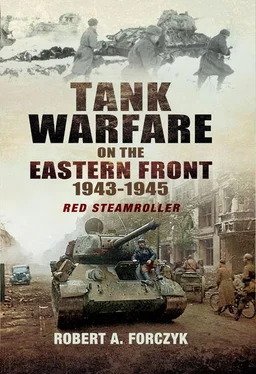Unlike the northern front of Operation Zitadelle , the operations of von Manstein’s southern pincer have been covered in great detail in a large body of literature and I do not intend to belabour this well-known side of the Battle of Kursk with a blow-by-blow description. In particular, this task has already been well accomplished by George M. Nipe’s Blood, Steel and Myth (2011) and Valeriy Zamulin’s Demolishing the Myth , which both provide great day-to-day detail on the fighting on the southern side of the Kursk salient. Instead, I intend to focus the remainder of my discussion of Zitadelle on the main implications for armoured warfare on the Eastern Front on three particular topics: (1) how von Manstein’s armour penetrated the Soviet obstacle belts, (2) the poor performance of the Panther tank in its initial combat debut and (3) Rotmistrov’s botched counter-attack at Prokhorovka. I also intend to avoid the simplistic pitfall of earlier analyses, which tend to base their assessment of Zitadelle upon numbers of operational tanks on either side and little else.
Hoth’s main attack began at 0500 hours (local) after a 45-minute artillery preparation. On the left flank, von Knobelsdorff’s XXXXVIII Panzerkorps attacked with the 3.Panzer-Division, Großdeutschland and 11.Panzer-Division advancing on line. The Panther-Abteilungen were still in their assembly area and did not move forward until about 0900 hours. There were still plenty of uncleared mines in the former Soviet security, which greatly complicated the forward movement of the German assault groups. Generalleutnant Franz Westhoven’s 3.Panzer-Division attacked with four of its Panzergrenadier-Baitallonen, without the planned armoured support, against the Soviet 210th Guards Rifle Regiment. After clearing out the frontline positions, the German battalions were stopped for nearly five hours by a deep, muddy balka. While the German pioniers established a crossing, Soviet artillery pounded the stalled Germans, inflicting heavy casualties. When the balka was finally bridged around 1400 hours, Westhoven’s infantry poured across, along with tanks from II./Panzer-Regiment 6, and attacked the village of Korovino. The village was captured, but Oberst Gunther Pape, commander of Panzergrenadier-Regiment 394, was badly wounded. A minor counter-attack by Soviet tanks was repulsed by the German panzers. Westhoven’s division had overrun a first-line rifle regiment and advanced a total of about 5km.
In the centre of the XXXXVIII Panzerkorps offensive, Generalleutnant Walter Hörnlein’s Großdeutschland conducted a very mismanaged attack from the outset. As with 3.Panzer-Division, uncleared mines wrecked the Großdeutschland ’s attack schedule. Oberst Hyazinth Graf Strachwitz’s Panzer-Regiment Großdeutschland did not arrive in time to support the division’s infantry in the attack. Oberst Erich Kahsnitz, commander of the Panzerfüsilier-Regiment Großdeutschland , was badly wounded in this unsupported attack and later died of his wounds. The III.Panzerfüsilier-Regiment suffered very heavy losses. {89} Finally clearing the mines, von Strachwitz pushed forward to catch up with the infantry, leading with his Tigers, then his two tank battalions. His objective was the village of Cherkasskoye, which was held by the 196th Guards Rifle Regiment and two anti-tank units. Visibility was hazy due to grassfires sparked by the artillery preparation. Only 30 minutes after crossing the line of departure, von Strachwitz was shocked to encounter a large flooded area, which was the 80-metre-wide Berezovyi ravine. The Soviets had placed barbed wire and mines on the enemy side of the ravine and recent heavy rains had turned the ravine into a mud bowl that ran laterally for about 3km across the front of Großdeutschland ’s axis of attack. Although some of Kahsnitz’s dismounted infantry made it across, no vehicle could cross until the pioniers had established a ford.
It is incomprehensible that Strachwitz and other senior commanders in the Großdeutschland were ignorant of this major obstacleafter having had three months to prepare for Zitadelle . In combat, even veteran commanders can make serious mistakes due to fatigue, but that was not the case here; Strachwitz and the leadership of Großdeutschland were well-rested after the long lull. It is a common theme in German memoirs that whenever some inexplicable mistake occurs, like Operation Typhoon in 1941 or the Berezovyi ravine in 1943, or the effort to relieve the Korsun Pocket in 1944, German tankers blame the Russian mud for their failures. In other words, circumstances were beyond their control. This was nonsense. Instead of executing a carefully planned deliberate attack, Großdeutschland conducted a movement to contact as if it was a training event. Adding to this failure, Strachwitz decided to try and send several tanks across, but they sank in the water-logged ground up to their fenders. Furthermore, he allowed the rest of his stationary regiment to bunch up south of the ravine, which invited a barrage of Soviet artillery and anti-tank fire. Even worse, Soviet Il-2 Sturmoviks arrived overhead and caught the Panzer-Regiment Großdeutschland flat-footed, dropping bombs that seriously wounded Oberstleutnant Graf Saurma, commander of II./Pz.Rgt. GD. [24]At least 20 of Strachwitz’s tanks and perhaps five assault guns were knocked out by mines, stuck in the mud or damaged by enemy fire before he finally decided to pull back and try and cross the ravine 1,500 meters to the west. {90}
Advance of Hoth’s Panzerarmee 4 on first day of Zitadelle, 5 July 1943.
Compounding this mistake, Strachwitz did not bother to inform von Lauchert’s Panzer-Regiment 39 about the obstacle. Von Lauchert managed to get a few hours to prepare the Panthers for combat in their assembly area before moving forward at about 0815 hours. Four more Panthers suffered engine fires before crossing the line of departure. Von Lauchert deployed both battalions in double row formation, with Hauptmann Heinrich Meyer’s Panzer-Abteilung 51 in the lead and Major Gerhard Tebbe’s Panzer-Abteilung 52 trailing. When Meyer’s Panthers reached the ravine, a number of Großdeutschland ’s immobilized tanks were still there and pioniers had attempted to create a crossing site with lumber. After a few minutes of confusion, Meyer tried to cross the ravine with his two lead companies, which resulted in a number of Panthers bogging down in the mud. Another company attempted to cross nearby and ran into a minefield, disabling the company commander’s tank. Soviet fire pounded the immobilized Panthers, damaging more tanks and creating complete confusion. A serious technical weakness in the Panther was also discovered: the Panther’s final drive was too weak to move in reverse on a slippery slope and some tanks sat immobilized or sheered the teeth off their drive sprockets in frantic efforts to escape the kill zone. By the time von Lauchert received word that Strachwitz had found a better crossing site to the west, at least 25 Panthers had been put out of action. There is little doubt that the Panther’s baptism of fire at Kursk was the worst combat debut for any major weapons system in the Second World War.
It took Großdeutschland ’s pioniers hours to bridge the Berezovyi ravine and it is important to note that they suffered very heavy losses from Soviet artillery, which had the obstacle completely covered by fire. Furthermore, German pioniers were clearing the minefields by hand – as was the case with all Hoth’s divisions – which was very slow and dangerous. It was not until 1600 hours that Strachwitz was able to cross the ravine with 30 Panthers, 15 Pz IVs and the SPWs of Major Otto Remer’s I./Pz.Gr. Regt. GD and attack Cherkasskoye. Finally able to advance, the Panther’s 80mm thick, sloped frontal armour easily shrugged off Soviet 45mm and 76.2mm anti-tank fire and enabled Remer’s Panzergrenadiers to fight their way into the town and clear part of it. However, Soviet riflemen held onto part of the town and did not abandon it until nightfall. Nearby, the 1837th Anti-Tank Regiment opened fire against the Panthers with 85mm anti-aircraft guns, which posed a serious threat. Podpolkovnik Matvyey K. Akoponov’s 245th Tank Regiment also made an appearance to support the retreating Soviet infantry, with its 27 M3 Grant and 12 M3 Stuart tanks. Von Lauchert’s Panthers knocked out about six of Akoponov’s American-built tanks before they retreated, but this was the culmination of the first day’s attack for Großdeutschland . At great cost, the best equipped division in the Heer had advanced 7km at great cost but only dented the 22nd Guards Rifle Corps’ first line of defence, not broken it. Mines had inflicted significant damage on the division, including nine of 12 Tigers immobilized. Indeed, Großdeutschland ’s attack resembled the kind of poorly-planned/poorly-executed armoured attacks that the Red Army had often mounted in 1941–42.
Читать дальше








![John Stieber - Against the Odds - Survival on the Russian Front 1944-1945 [2nd Edition]](/books/405234/john-stieber-against-the-odds-survival-on-the-russian-front-1944-1945-2nd-edition-thumb.webp)



